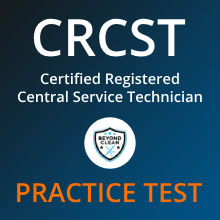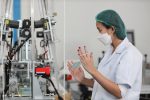We prepared a sample practice test for the CRCST (Certified Registered Central Service Technician) with 30 questions, each featuring four answer choices, only one of which is correct, the correct answer is provided.
Following this practice test, we provide several tips for preparing for the CRCST exam.
Sample CRCST Practice Test
Question 1: What is the primary purpose of sterilization?
A) To reduce the time of instrument processing
B) To eliminate all microorganisms
C) To make instruments look clean
D) To preserve the lifespan of instruments
Correct Answer: B) To eliminate all microorganisms
Question 2: What does the acronym “CSR” stand for in the context of central service?
A) Central Service Room
B) Central Sterile Reprocessing
C) Certified Surgical Resident
D) Central Supply Resources
Correct Answer: B) Central Sterile Reprocessing
Question 3: Which of the following methods is commonly used for sterilizing heat-sensitive instruments?
A) Steam sterilization
B) Ethylene oxide gas sterilization
C) Dry heat sterilization
D) Chemical sterilization
Correct Answer: B) Ethylene oxide gas sterilization
Question 4: What is the minimum temperature required for steam sterilization?
A) 100°C
B) 121°C
C) 150°C
D) 180°C
Correct Answer: B) 121°C
Question 5: How often should biological indicators be tested in a sterilization process?
A) Once a year
B) Every sterilization cycle
C) Weekly
D) Monthly
Correct Answer: B) Every sterilization cycle
Question 6: What is the primary function of a flash sterilizer?
A) To sterilize large quantities of instruments
B) To provide rapid sterilization for immediate use
C) To store sterile instruments
D) To cool down sterilized instruments
Correct Answer: B) To provide rapid sterilization for immediate use
Question 7: Which of the following is a critical item in the sterile processing department?
A) Cleaning brushes
B) Surgical instruments
C) Gloves
D) Marking pens
Correct Answer: B) Surgical instruments
Question 8: What is the purpose of the pH test in sterilization?
A) To check the water temperature
B) To assess cleaning efficacy
C) To ensure proper sterilant concentration
D) To verify instrument weight
Correct Answer: C) To ensure proper sterilant concentration
Question 9: What should be done with single-use items?
A) Reprocess them
B) Discard them after use
C) Store them for later use
D) Share them with other departments
Correct Answer: B) Discard them after use
Question 10: Which type of detergent is most effective in the decontamination process?
A) Acidic detergent
B) Enzymatic detergent
C) Abrasive detergent
D) Alkaline detergent
Correct Answer: B) Enzymatic detergent
Question 11: What is the first step in instrument processing?
A) Sterilization
B) Packaging
C) Decontamination
D) Distribution
Correct Answer: C) Decontamination
Question 12: What is the purpose of an ultrasonic cleaner?
A) To sterilize instruments
B) To visually inspect instruments
C) To remove debris from instruments
D) To dry instruments
Correct Answer: C) To remove debris from instruments
Question 13: Which of the following should be used to test the function of steam sterilizers?
A) Chemical indicators
B) Biological indicators
C) Mechanical indicators
D) Physical indicators
Correct Answer: B) Biological indicators
Question 14: What type of packaging material is best for steam sterilization?
A) Plastic wrap
B) Paper
C) Fabric
D) Aluminum foil
Correct Answer: B) Paper
Question 15: What is the minimum exposure time for steam sterilization at 134°C?
A) 3 minutes
B) 5 minutes
C) 10 minutes
D) 15 minutes
Correct Answer: B) 5 minutes
Question 16: Which of the following items must be sterilized after being cleaned?
A) Non-critical items
B) Semi-critical items
C) Environmental surfaces
D) Single-use items
Correct Answer: B) Semi-critical items
Question 17: Which sterilization method uses dry heat?
A) Ethylene oxide
B) Steam
C) Hydrogen peroxide gas plasma
D) Dry heat oven
Correct Answer: D) Dry heat oven
Question 18: How should sterile supplies be stored?
A) On the floor
B) In a humid environment
C) In a clean, dry area
D) Exposed to sunlight
Correct Answer: C) In a clean, dry area
Question 19: What is the role of the Central Service Technician during the sterilization process?
A) Performing surgical procedures
B) Ensuring proper cleaning and sterilization of instruments
C) Administering anesthesia
D) Managing patient care
Correct Answer: B) Ensuring proper cleaning and sterilization of instruments
Question 20: Which statement about chemical indicators is true?
A) They confirm the sterilization of the instruments
B) They change color to indicate proper conditions have been met
C) They are not necessary if biological indicators are used
D) They are used only in steam sterilization
Correct Answer: B) They change color to indicate proper conditions have been met
Question 21: What is the recommended method for cleaning instruments before sterilization?
A) Washing in cold water
B) Manual cleaning only
C) Automated washing with an instrument washer
D) Just rinsing with water
Correct Answer: C) Automated washing with an instrument washer
Question 22: What is an important factor in the efficacy of sterilization?
A) The color of the packaging
B) The type of sterilization used
C) The weight of the instruments
D) The size of the sterilization room
Correct Answer: B) The type of sterilization used
Question 23: Which item is classified as a non-critical item?
A) Endoscopes
B) Surgical instruments
C) Bedpans
D) Forceps
Correct Answer: C) Bedpans
Question 24: What is the purpose of a biological indicator?
A) To ensure the appearance of sterility
B) To provide a visual inspection method
C) To confirm the sterilization process was effective
D) To reduce instrument weight
Correct Answer: C) To confirm the sterilization process was effective
Question 25: How often should the sterilization equipment be maintained?
A) Once a month
B) As needed
C) Only when it breaks
D) Every shift
Correct Answer: B) As needed
Question 26: What is the correct way to load an autoclave?
A) Pack instruments tightly together
B) Ensure steam can circulate freely
C) Load with the heaviest items on top
D) Overload to maximize space
Correct Answer: B) Ensure steam can circulate freely
Question 27: What is a key characteristic of a steam sterilizer?
A) It uses high pressure and temperature
B) It requires no monitoring
C) It can sterilize only metal instruments
D) It is used for cleaning, not sterilizing
Correct Answer: A) It uses high pressure and temperature
Question 28: Which of the following materials should not be used for sterilization?
A) Stainless steel
B) Rubber
C) Glass
D) Plastic
Correct Answer: B) Rubber
Question 29: When should gloves be worn in the Central Service department?
A) Only when handling sterile instruments
B) During all cleaning and sterilization processes
C) Only when the floor is wet
D) Gloves are not necessary
Correct Answer: B) During all cleaning and sterilization processes
Question 30: Which of the following is the best practice for ensuring proper sterilization?
A) Relying solely on visual inspection
B) Using only chemical indicators
C) Regular training and adherence to protocols
D) Processing instruments quickly
Correct Answer: C) Regular training and adherence to protocols
7 Tips to Prepare for the CRCST Test
Preparing for the CRCST test requires a strategic approach.
Here are seven effective tips to help you succeed:
1. Understand the Exam Content
- Familiarize yourself with the CRCST exam blueprint, which outlines the key topics and competencies covered. Focus on areas such as sterilization methods, instrument processing, and safety protocols.
2. Use Study Materials
- Invest in recommended study guides, textbooks, and online resources specifically designed for the CRCST exam. Consider using the “Central Service Technical Manual” as a primary resource.
3. Create a Study Schedule
- Develop a structured study plan that allocates time for each topic. Break down the material into manageable sections and set specific goals to track your progress.
4. Practice with Sample Questions
- Take practice tests and quizzes to familiarize yourself with the question format. This will help you build confidence and identify areas where you need more review.
5. Join a Study Group
- Collaborate with peers preparing for the same exam. Discussing topics and sharing knowledge can reinforce your understanding and provide different perspectives.
6. Focus on Hands-On Experience
- If possible, gain practical experience in a central service environment. Understanding real-world applications of sterilization and instrument processing will enhance your theoretical knowledge.
7. Stay Calm and Manage Stress
- Practice relaxation techniques such as deep breathing or meditation leading up to the exam. A positive mindset and good stress management can significantly improve your performance on test day.
By following these tips, you’ll be well-equipped to tackle the CRCST exam confidently!
Good luck!
This page is also available in Spanish.










